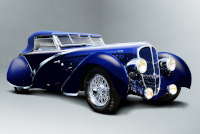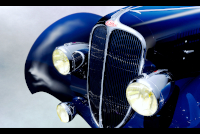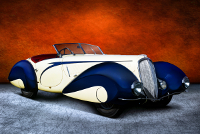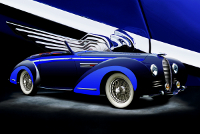Location:
Elegance at Hershey, 2019
Owner: Ken & Ann Smith | La Jolla, California
Prologue:
As I put together the various flank portraits you see here, I decided to remove the CCCA badge, (visible on the main portrait). The placement of the badge between the bonnet and the door encroaches on the panel lines, and while it's true to the car as shown today, it's perhaps best to inspect the lines and curves as originally designed.
While transitioning from an old computer to a new machine, I began this gallery because we'd just returned from Hershey and I had no other stock available. At the time, I'd meant to work on more Bugatti and Duesenberg cars. But, I was also excited by the prospect of working up the six portraits shown here. I've always been partial to portrait orientation, and find that it's vastly overlooked by people who point cameras at cars. As for the Delahaye, I regret not spending adequate time with the rear skirts and the tail. I only realized later how interesting the reflections would be, mixed with high-contrast manufactured light. And because the car hails from California, I don't suppose we'll be seeing her again soon.
- - - - - - - - - -
► Image Source: Nikon D750 (24.3 MP) | Image 4 is slightly larger, finished at 26.5 MP.
References:
- UltimateCarPage: Featuring chassis #46864, by Wouter Melissen, July 7, 2008.
- ConcoursCoaches: The owner and concession of record in La Jolla, California as of first writing this profile.
Not to over-state the importance of old cars, there are a few attributes of this Delahaye that lend it prestige among the grand marques. Chassis #46864 is a very early Figoni et Falaschi-bodied cabriolet; it is complete and original. The car features a disappearing cabriolet top filed under patent by the coachbuilder. The car also has the distinction of beginning its life in the close company of the Figoni family, as its first owner was a personal friend. And toward the end of the 20th century, the car passed through Hill & Vaughn, restoration concern of the late American Formula 1 World Champion, Phil Hill. Taken together, these attributes make #46864 a stand-out among the 135 line.
Many sources available online reference the patent number 795.769, filed October 1, 1935 and granted January 13, 1936, for the stowable hood. The one-time concessionaire, Concours Coaches, also provides snippets of the patent brief and accompanying technical drawings. But the use of this mechanism is not exclusive in its general concept.
Georges Paulin conceived a retractable hardtop at the same time, its operation nearly identical to this soft-top variant, and the Walter M. Murphy Company of California had already developed a disappearing top roadster in the late 1920s, one that became rather standard for two-passenger Duesenberg Model Js. Placed in context, the Delahaye Disappearing Top Cabriolet is possibly unique among Delahayes, but pioneering in the shared sense of being au courant, moving with the fashion of the time.
Apart from aesthetics, the practical reason for the disappearing top design is aerodynamics. Special-ordered on a long-chassis, this competition-spec car features many components akin to those sports cars of the time that dabbled in racing. These components include triple carburetors, high-compression head, an oil cooler, aluminum clutch housing, competition-style radiator tank, right-side hand brake, single-plate firewall, and two fuel fillers, one on each side under the back deck. Completely enclosing the top would reduce drag and eliminate buffeting from the external mechanisms common to decapotables. Still, the svelte shape of this cabriolet isn't dissimilar from Figoni et Falaschi luxury craft produced through the end of the decade.
Some make much of dual-purpose, road and racing history. This car claims participation in the 1949 Rallye Monte Carlo, a storied and rather taxing event that any team should be happy to complete. But ask how a wealthy Parisian owner lets a car of this beauty to the mishaps of the Monte Carlo Rally, and the answer seems to reside in the date of competition.
In the post-War era, racing cars were scarce on the ground. So, many pre-War sports car survivors were brought out of hiding and quickly fitted for racing. Racing-derived models from Alfa Romeo, Bugatti, Delahaye, and Talbot Lago were prime candidates for substitute race machinery. Not until the 1950s would the industry generate real motor racing momentum. For this reason, (and, while it hasn't been written in so many words), this scenario is probably what prompted Claude Figoni, Joseph Figoni's son, to contact his father's friend about using this Delahaye for racing after the War. Guy Mairesse and Paul Vallée were the drivers; they finished in sixth place.
I don't like to speculate about first owners whose personal histories may be provincial, but not otherwise noteworthy (or at least not well understood). Parroted by numerous sources, the original purchaser of #46864 was M. Wolf. Two years after appearing in the Rallye Monte Carlo, now an old sports car, the car was sold to Jacques Persin, Director General of Facel Cars. Chassis #46864 then moved from Paris to Pittsburgh PA in the middle 1950s, either through the third owner, American ex-pat Peter Gargola, or through the fourth owner, vintage car collector Dr. Earle M. Heath. From Heath, the car passed to another well known collector, William E. Connor. Once on the west coast, the Delahaye underwent restoration at Hill & Vaughn. At the time, much of the car's history had not been put together. A second restoration at Alan Taylor in Escondido brought the car to its current finish, which garnered CCCA 100-point recognition.
Motor: 3,557 cc straight 6-cylinder, cast-iron block and hemi-head | 84 mm x 107 mm | 7.0:1 compression | #46864
Valvetrain: OHV, 2 valves per cylinder
Aspiration: triple Solex 40 PAI carburetors
Power: about 120 bhp @ 4,200 rpm
Drivetrain: 4-speed manual gearbox
Front Suspension: transverse semi-elliptic leafsprings with top links, and transverse RAX friction dampers
Rear Suspension: live axle with quarter-elliptic leafsprings and transverse RAX friction dampers
Architecture: steel ladder frame chassis with coachwork by Figoni et Falaschi
Wheelbase: 2,950 mm (116.1 inches)
Etymology:
The Delahaye 135 is a sporting derivative of the well-to-do 138 Superluxe. The 'M' designation stands for 'modifié,' and often denotes triple-carburetor intake. The carrosserie Figoni et Falaschi is responsible for the body's design and execution, including the disappearing top mechanism, which was filed under patent 795.769.
Figures:
More than 450 Delahaye 135 Competition cars break down between long chassis and short chassis versions. This car, #46864, is a long chassis version; it is a very early car within the line, and the only disappearing top cabriolet.
Bleu Fonce: The Dark Blue Effect
I've tried to play up the deep sapphire glow of the paint, which was once captured nicely in a photograph set by (I believe) Scott Williamson. Shiny dark surfaces work marvelously for striking brightwork, and sets off the chrome dart that wraps over the bonnet from the center of the nose, down to the leading edge of the rear wheel skirts.
Disappearing Top: Figoni's Take on a Classic Era Mechanical Element
The entire back deck opens on hinges at the base, near the rear guard. The hood stows into the hatch along with the spare, lowering on armatures overtop the luggage shelf immediately behind the seats. This retractable hood mechanism is very similar to Paulin's foldable hardtop design.
Line and Curve: Early Figoni Design on the Delahaye 135 Chassis
The car's low stance and linear body offer more planar surfaces than the famous French curve concept might admit, and the overall aspect seems to predict the smooth designs of Lincoln yet to come in the post-War era. In this respect, the rear portions of the car display a more modern design than the front. From the flank and across the rear deck, composite curves build together with the chrome dart, and the skirts sweep up toward the tail. Once again contradicting the French curve theme, two rows of progressively taller louvres trail down the bonnet sides. These louvres follow the bend of the chrome dart, but rather accentuate the length of the nose. Taken together, the beauty of the design comes from curves applied to an otherwise linear form.
Applying curves to a linear form results in a series of sharp points. Sharp front skirts propose a mantis-like posture, hinting at a speedy, slicing approach to the wind. The brightwork includes arrow points that meet the nose on the top of the bonnet, scythe-like accents on each of the skirts, the deep vee of the massive chrome dart, and small points at the end of the chrome dart that face the chrome plates framing the tail lights.
Most intriguing, the center line of the bulkhead, just aft of the bonnet hinge, pinches into a gentle fin. The lower edge of the tiltable windscreen frame accentuates the fin, shaped in a sharp scallop to fit over the crimped cowl.
Exaggerated by tilting the windscreen open, the sharp points of the windscreen edge are unusual even among French coachwork designs. Few designs carry the dorsal fin motif to the front of the car, but Figoni has done just that. With my apologies, I did not depict the back deck, where the dorsal fin ends at the base in a smooth chrome dollop.
Traps and Buttons: Details and Conventional Fittings
The car wears 17-inch Rudge-Whitworth wire wheels. Headlamps and driving lights are Marchal. The external wiper armatures and tilting windscreen make lovely complication across the bulkhead. Note, however, that the disappearing top design uses no external irons, a nod to modernity.
Last Updated: Mar 26, 2025











